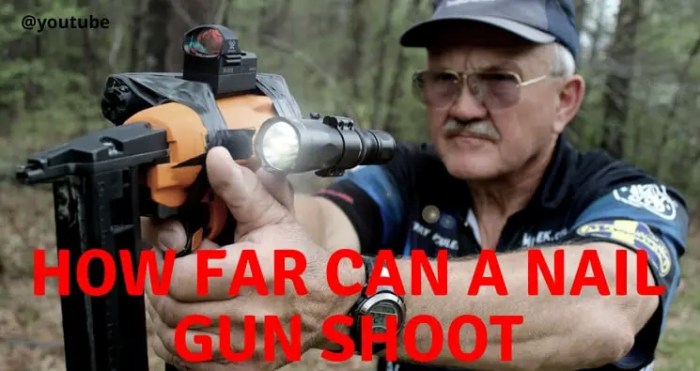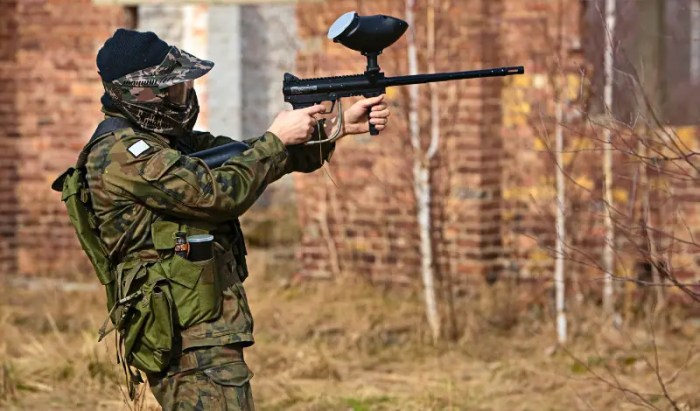How far can a gun shoot? This seemingly straightforward question delves into the intricate world of firearm technology, ballistics, and practical applications. From the humble beginnings of early muskets to the precision rifles of today, the evolution of gun range has been shaped by advancements in engineering, materials, and ammunition.
This article embarks on a comprehensive journey to uncover the factors that govern the maximum distance a gun can shoot, exploring its historical context, practical applications, measurement techniques, legal considerations, and future developments.
Historical Evolution of Gun Range

The evolution of firearm technology has significantly extended the range at which guns can shoot. Early firearms, such as muskets, had a limited range of a few hundred yards due to their smoothbore barrels and rudimentary gunpowder.
The invention of rifling in the 16th century dramatically increased the range and accuracy of guns by imparting spin to the projectile, stabilizing its flight. Improvements in gunpowder composition and bullet design further extended the range of firearms.
Notable firearms throughout history, such as the Brown Bess musket (effective range of 300 yards), the Springfield Model 1861 rifle (effective range of 1,000 yards), and the M16 assault rifle (effective range of 600 yards), exemplify the advancements in gun range over time.
Factors Affecting Gun Range
The maximum distance a gun can shoot is influenced by several key factors:
- Barrel length:Longer barrels provide more time for the gunpowder to burn and accelerate the projectile, resulting in a higher muzzle velocity and increased range.
- Caliber:Larger caliber bullets have a higher mass and therefore retain their velocity better over longer distances, resulting in a longer range.
- Bullet weight:Heavier bullets have a higher sectional density and are less affected by wind resistance, resulting in a longer range.
- Wind conditions:Wind can significantly affect bullet trajectory and velocity, reducing the effective range of the gun.
Practical Applications of Gun Range
Gun range is a crucial consideration in various practical applications:
- Hunting:Hunters need to consider the effective range of their firearms to ensure accurate and ethical shots.
- Target shooting:Target shooters compete at various distances, requiring firearms with extended ranges for precision shooting.
- Self-defense:The effective range of a firearm is critical for self-defense situations, ensuring that the defender can engage the threat at a safe distance.
- Military operations:Military firearms are designed with specific range requirements, enabling soldiers to engage targets at various distances in combat situations.
Measuring Gun Range
The range of a gun can be measured using several methods:
- Rangefinders:Electronic devices that measure the distance to a target using lasers or other technologies.
- Ballistic tables:Charts that provide the expected range of a particular firearm and ammunition combination based on environmental conditions.
- Empirical testing:Firing the firearm at known distances and recording the point of impact to determine the effective range.
Legal and Ethical Considerations: How Far Can A Gun Shoot

Gun range is subject to legal regulations and ethical considerations:
- Safe shooting distances:Gun owners are responsible for ensuring that they shoot at safe distances to avoid endangering others or property.
- Legal restrictions:Some jurisdictions have laws regulating the maximum range at which firearms can be discharged.
- Ethical responsibilities:Gun owners have an ethical obligation to use their firearms responsibly and avoid excessive or reckless shooting.
Advanced Gun Range Techniques

Advanced techniques can extend gun range beyond standard capabilities:
- Specialized ammunition:Ammunition designed for long-range shooting, such as match-grade or high-ballistic coefficient bullets, can improve accuracy and range.
- Long-range optics:Scopes with high magnification and precision reticles enable shooters to engage targets at extreme distances.
- Precision shooting methods:Techniques such as benchrest shooting and long-range marksmanship improve accuracy and extend the effective range of firearms.
Future Developments in Gun Range
Advancements in firearm technology may further extend gun range:
- New materials:Lightweight and durable materials, such as carbon fiber, could enable the development of firearms with longer barrels and improved accuracy.
- Innovative designs:Novel firearm designs, such as bullpup configurations, could reduce overall length while maintaining or extending range.
- Emerging technologies:Advancements in electronics and optics could lead to more precise rangefinders and targeting systems, enhancing the accuracy and range of firearms.
Questions Often Asked
What factors influence the maximum distance a gun can shoot?
Barrel length, caliber, bullet weight, and wind conditions play crucial roles in determining the maximum range of a gun.
How is gun range measured?
Rangefinders, ballistic tables, and empirical testing are commonly used methods for measuring gun range, each with its own accuracy and limitations.
What are the legal considerations surrounding gun range?
Safe shooting distances and responsible gun ownership are paramount legal and ethical considerations when using firearms.
How can gun range be extended beyond standard capabilities?
Specialized ammunition, long-range optics, and precision shooting techniques can be employed to extend gun range beyond its standard limits.
